Introduction
Valves are integral components in piping systems they are the primary method of controlling
the flow, pressure and direction of the fluid. Valves may be required to operate continuously
e.g. control valves, or they may be operated intermittently e.g. isolation valves, or they may be installed
to operate rarely if ever e.g. safety valves.
A valve can be an extremely simple, low cost item or it may be and extremely complicated, expensive item.
In piping design the valves probably require more engineering effort than any other piping component.
Valve Classifications
Isolation/Stop valve-
The isolation of the downstream system from the upstream system by use of and
isolation /stop valve is a critically important function..The prime requirements of this valve are
tight shut off when closed and minimum restriction to flow when open.
Valves used for this function include gate valves, globe valves, ball valves,
plug valves, butterfly valves, diaphragm valves and pinch valves
Regulation of flow
Many applications require the flow of the fluid be regulated (throttled) at some fixed
or variable level between fully zero and maximum flow limits. This is achieved
by introducing resistance to flow, or by bypassing flow or by changing the direction of the
flow. An important feature for control valves is that the output variable (flow)
is related to the input variable (valve position). An ideal operating characteristic of
a hand operated flow control valve is that the flow is directly proportional to the position
of the handwheel
Valve types for this function include globe, needle, ball, butterfly. Globe
and needle valves are best suited for this duty but ball valves are also easily adapted
to give reliable flow control..
Back flow prevention
In some circumstances it is important to prevent reversed fluid flow. The type of
valve for this duty is a non-return-valve (NRV) or check valve. The important criteria
when selecting these valves are, tight shut off against reverse flow, low resistance to flow for forward
flow, fast response. The valve can be operated to close by gravity, fluid flow , or spring.
Two main valve types are available for this function lift check valves or swing check valves.
Pressure Regulation
In many applications, more generally associated with gases, there is a need to reduce the
supply press to a set fixed value. It is also necessary to maintain this reduced
pressure over a range of fluid flow conditions. The pressure regulator valve is
engineered for this application. The valve is basically a globe valve biased open by an
adjustable spring force with the feedback pressure tending to move the valve to a closed position such
that at the set pressure the feedback pressure force just exceeds the spring force
The pressure regulator valve operates using the downstream fluid pressure as feedback.
This is mostly taken from within the valve (self acting). For more accurate control
a feedback connection can be taken from the downstream piping.
The pressure regulation at low near zero flows is difficult and it is often necessary
to include internal or external relief valve functions to ensure no high pressures in the
downstream system.
Pressure Relief Valves- Safety valves
A very important valve for safety is the pressure relief valve. This valve is used
in applications where excessive pressure in the system can cause damage or failure or can introduce
a safety risk. Uncontrolled excessive pressures can result in disastrous accidents e.g.
when potentially explosive gases are being controlled. Relief valves are mainly
spring loaded but they can also be gravity operated and other more specialised designs are available.
The bursting /ruputure disc must be included under the general heading of safety valves. This
is simply a disc which ruptures when a set pressure is exceeded. The fluid then escapes through
the ruptured disc. If the bursting disc operates the system has be be closed down and vented and the
bursting disc is then replaced
Relief valves when used for safety applications are engineered in line with safety regulations
and require regular inspections to confirm the settings and the operation.
An important part of the relief valve installation is the routing of the relieved fluid.
This pipe route must be to a safe location and must be engineered such that it is always fully open.
Special and miscellaneous valves
There are a wide variety of special valves developed for specific industries.
Fluid Properties and operating conditions
The properties of the fluid to be controlled have a major impact on the design and materials of
construction of the valve. The piping industry, over the years, had developed a wide
range of valve designs and material to handle virtually all of the fluids being handled.
The selection of the valve should take into account fluid viscosity, temperature, density and flowrate.
The valve must be suitable to withstand resulting corrosion and erosion and if necessary the valve
may have to be designed for no internal hold up of fluids.
Important considerations include for absolute internal and external leak tightness when handling
toxic or explosive fluids.
There regulations also include for the need for a firesafe valve to maintain its
internal and external integrity when the valve surrounded by flames from a fire..
Valve Connections
There are a number of methods of connecting valves into the
piping systems- as follows
- Flanges .. The valve is provided with suitable rated flanges.
- Wafer .. The valve is provided with suitable sealing faces and is trapped between line flanges.
- Butt Welded ..The valve is provided with butt weld end and welded into the piping system using high integrity joints.
- Socket Welded ..Socket welds allow and welded into the piping system using fillet welds.
- Screwed Ends .. Ends can be provided with female or male screwed ends . The threads can be taper or parallel
- Compression Fittings .. Ends can be provided with compression fittings
|
Valve Containment
An important requirement in valve design is to minimise the leakage of fluids into
the surrounding environment. This is very important in the nuclear industry
and when transferring toxic or flammable fluids. The possible leakage points
on valves are listed below.
- The end connections with the piping.-
- The spindle gland seals -allowing axial and rotary motion.
- For top entry valves the sealed top closure joint
- For three piece ball valves - the two split joints
- Valve drain connections and vent connections
|
The best option for minimising risk of leakage from the pipe connections is to use butt welded joints
which can be verified by non-destructive-testing(NDT). This option obviously eliminates the valve
types which have to be removed for maintenance.
The options for eliminating risk of gland leakage is to use bellows sealed valves. The risk can
also be reduced by incorporating dual seals with a test point between. Pinch valves and
diaphragm valves do not include gland sealing and are therefore not at risk of gland leakage.
Flow Factors
It is clear that different sized valves have different flow rate capacities and it is very
important to be able to assess the flow through a valve for a fluid at certain conditions.
The flow characteristics for an on-off valve are fixed and can be evaluated directly using the relevant flow factor. The flow
through flow control valves, relief valves, pressure reducing valves and check valves depend
on the operating condition for the valve and require a more detailed evaluation..
The most general method of identifying
the flow capacity of a valve is the C v Factor..
The C v factor based on american imperial units and is defined as follow
C v = The flow of water through a valve at 60 oF in US gallon/minute at a pressure drop of 1 lb/in2
The metric flow factor (K v) is used throughout outside of america and is defined as follows
K v = the flow of water through a valve at 20 oC in m3/hr with a pressure drop of (1 bar)
The conversion between the two factors is K v = 0.865 C v
Also kv is defined as follows...
k v = the flow of water through a valve at 20 oC in litres/min with a pressure drop of (1 bar)
The conversion between k v and C v is ...k v = 14.42 C v
Liquid Flow
To establish the flow ( Q ) in litres /m at a differential pressure
( Dp )in bar for a liquid
with a specific gravity relative to water ( sg ).

Note: This relationship only applies for liquids similar to water at reasonable flows (sub-sonic).
Gas Flow
For gases and supersonic flows more complicated formulae are required....
The formulae below
must be used only for rule of thumb estimates. The assumption that the critical
Dp is at P1 /2 does not hold for all valves.
For accurate flow calculations the valve manufacturers data sheets must be used
For gases flowing at sub-sonic velocities the following relationship holds..

T1 = Inlet gas temperature deg K = Deg C + 273
sga =Gas specific gravity relative to air
q n = gas flow at normal conditions ...
P1 = Inlet Pressure (absolute)
For gases flowing at super-sonic velocities the following relationship holds..

|
Gas Reference conditions
Normal conditions: P=1013.25mb and T=273.15K
Standard conditions: P=1013.25mb and T=288.75K.
|
VALVE DESCRIPTIONS
Gate Valves
Gate valves are generally used in the process industry for on-off service. The design is
not suitable for throttling duty because the sealing surfaces can easily suffer from
wire drawing (erosion) when low flows are being maintained against high differential
pressures and the design give very poor flow control characteristics..
The gate valve can be manufactured in a wide range of sizes from 5mm to above
2000mm dia. The designs are proven and well tested.
There is a tendency to move to butterfly valves as a lower cost
option.
The valve can be based on a solid wedge, a wedge which can adjust to suit the
seal faces, or a parallel faced based on two discs which slide between parallel
sealing faces with a mechanism form forcing the discs out on the last part of
the spindle travel. The valve can be based on a simple rising spindle
design or a fixed spindle which screws into the gate..
There are a large number of gate valve variations including slide valves, knife valves,
penstock valves, sluice valves, and venturi valves.
|
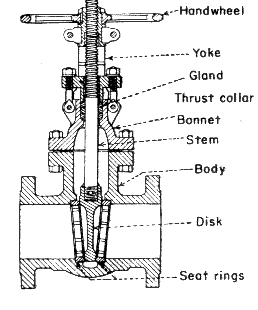
Rising Spindle Gate Valve
|
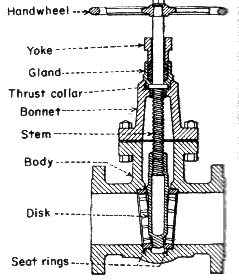
Fixed spindle Gate Valve
|
Globe Valves
The globe valve includes an orifice set into the body through which the fluid flows.
A disc located on the end of the spindle is engineered to move in and out along the
axis of the orifice. When the disc is moved to sit in the orifice the
flow path is shut-off. The flow path is progressively increased as the
disc is moved away from the orifice.
The surface of the orifice (seat)
is generally engineering as a replaceable item made from erosion resistant material
with a polished surface finish. The disc can be fitted with a soft seat
if a tight shut-off is required. For flow control duties the disc
is supplied with an engineered shape often with a contoured skirt.
For manually operated valves the spindle screwed so that rotation of the handle moves the disc
in and out. For actuated control valves the spindle is moved in and out using a linear
actuator which can be pneumatic, hydraulic or electric..
The fluid flow path through globe valves is such that there is normally a high fluid head loss through
the valve. The inline body design has the highest head loss, the angle pattern body design
has a lower head loss. There are certain designs of globe valves which have been engineered
to have low head loss characteristics. (Ref Dynamic Controls cartridge valves)..
Globe valves are supplied in sizes from 3mm bore through 400mm and can be used, size limiting at
pressures up to 450 barg. Depending on the sealing systems the valves can be used
at temperatures up to 600 oC.
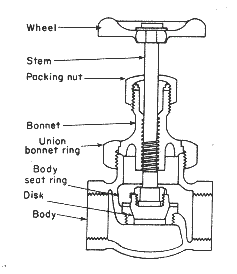
Small Size Screwed Globe Valve
Needle Valves
The needle valve is used specifically for accurately controlling the flow of fluids at low flows. The valve is basically
a globe valve without the disc. It is generally used provided in small sizes of up to 20mm bore..
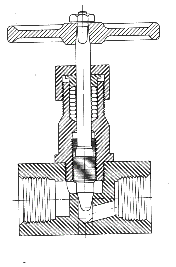
Needle Valve
Plug Valves
The plug valve is the oldest of the valves. Plug valves have been in use for over 2000 years.
This valve has been in continuous development over recent years.
The plug valve is basically and on-off valve based on a plug with a rectangular hole through which the fluid flows. The plug is either tapered
or cylinderical and is located in the valve body and can be rotated through a quarter turn to line the hole
up with the pipe when open or across the pipe when closed.
The plug can be adapted for multi-port use allow the valve to be used for diverting flow.
The valve can be engineered with a lubricated plug which uses the lubricant to enable
convenient operation over a wide range of pressures. The lubrication film also
provides a seal.
The unlubricated design includes seals in the plug and requires plastic bearing systems.
The valve can include a cage between the plug and the body which includes the bearing a sealing systems
and allow convenient maintenance. These valves have be specially developed for use in industries requiring
high performance operation under arduous conditions and allowing remote maintenance e.g. the nuclear industry.
The valve is a full bore and has virtually no internal cavities..
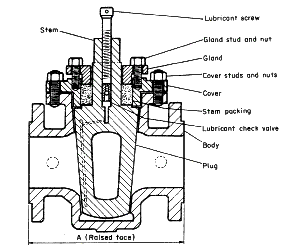
Lubricated Plug Valve
Ball Valves
The ball valve is basically a plug valve with a spherical plug and a round hole. Over recent years the
materials of construction of the ball valve have been developed such that the ball valve is becoming
the most popular valve for most process applications. There are two primary options for the
ball valve design
- Floating Ball Design- This is low cost option for the lower duties
- Trunnion Ball Design- This is a more costly option for the higher duties
|
The ball valve is generally provided as a reduced bore design allowing a smaller body but still
with relatively low head loss compared to most other valve options e.g 25nb valve has a 20mm reduced bore,. The full bore option
has a larger body but provides zero restriction to flow. The valve
can be supplied as a multi-port design
for flow diverting but only with the reduced bore option
The engineering of the ball valve has to include for fitting and removing the ball and seat system.
Ideally this has to be engineered to enable the valve to be maintained inline.. One method
of achieving this is to use the top-entry version - all of the internals are accessible by
removing the top flange. Another method is to use a three piece body based on a central piece sandwiched between
two pieces connecting the valve to the pipework. The central piece can be released and pivotted away from
the two outer pieces allowing access to all of the valve components.
The ball valve can be engineered as a multi-port valve for flow diverting duties.
An important advantage of all full bore valves is that the valve allows certain pipe
cleaning operations e.g rodding . Ball valves can also be used on branches
to enable instruments to be fed into pipe systems during operating periods.
Ball valves are available in all materials in sizes from 5mm to over 600mm.
The valves can be used at pressures up to 700 bar. The main components limiting
the performance of ball valves are the ball seals and valves are available with metallic seals.
|

Ball Valve - With Floating Ball
|
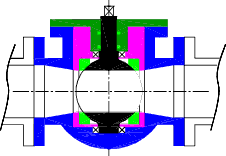
Ball Valve Trunnion Mounted
|
Butterfly Valves
The butterfly valve has head loss characteristics of a full bore valve.
The design is based on use of an engineered disc of the same dia as the bore of
the pipe arranged to pivot such that when it is across the bore is closes off the
flow path. When turned through 90o the disc provides minimum resistance to the flow. The valve is a quarter turn valve.
The main variations for this valve are the methods of sealing the perimeter of the disc in its closed
position. The simplest variation is to use an elastomer lined bore which is an
interference fit on the disc. The other variations are based on offsetting the disc plane from
the axis of rotation allow the disc to close against a circular face seal such that the fluid pressure
increases the seal effect. Metallic seals are available allowing the valve to be
used for a wide range of fluids at high temperatures
The butterfly valve has been developing such that for many duties it now provides optimum solution
for a leak tight on-off valve supplanting the gate valve. The butterfly valve can be engineered
as a small valve of 25mm bore and can be made for extremely large sizes above 5000mm bore. Depending on
the valve size working pressures up to 100 bar can be handled

Butterfly Valve - Lined
Diaphragm Valves
The diaphragm valve has a significant advantage over most of the other available designs, apart from the
pinch valve, in that there is no gland seal requirement. The fluid flows straight through
the valve via a chamber over which is an elastomer diaphragm. This diaphragm is normally arranged
to provide no resistance to the flow. The perimeter of the diaphragm is simply clamped
to a seal face of the valve body as a static seal.
To close off the valve the diaphragm is simply forced down into the chamber to block off the flow.
The chamber can include a weir across the flowpath against which the diaphragm can be pressed to affect a more
efficient seal with reduced diaphragm distortion.
The straight through variation is effectively a full bore valve design with all the associated benefits.
However this option results in a much more arduous duty on the diaphragm which has to be a softer material
This type of valve is manufactured in sizes from 6mm to 400mm and is generally
limited to relatively low fluid pressures (less than 7 barg).
However in the smaller sizes (up to 50mm) valves can be specially engineered for use at pressures up to 30barg.
The diaphragm must be chosen to be compatible with the fluid. Whatever the fluid the diaphragms
must be replaced at regular intervals and it is advisable to operate the valves frequently.
These valves are often used for duties which require a high degree of cleanliness as they
can be supplied lined, and polished and can be very conveniently cleaned.
|
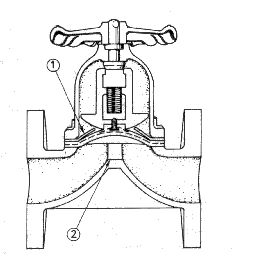
Diaphragm Valve - With weir
|
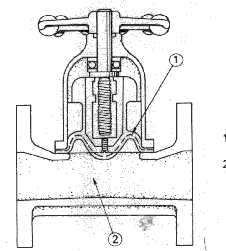
Diaphragm Valve - straight
|
Pinch Valves
The pinch valve is a theoretically ideal solution for fluid on-off duties. The valve is simple
a length of pipe made from an elastomeric material with a mechanical system for squeezing the tube
closed when a shut off is required. The valve is a true full bore valve - there are no mechanical
parts in contact with the fluid- The operation of the valve is ideally simple- The valve can be easily engineered
as a tight-shut off valve..
The valve is often supplied with the pinch tube contained within a outer pipe between
the end flanges. This option provides a method of monitoring for tube leaks and
provides a degree of secondary containment
The valve has similar limitations to the diaphragm valve. The diaphragm valve
is really a variation on the pinch valve principles..
Pinch valves are supplied is for diameters 25 mm - 1000 mm, temperatures -50 C - +160 C, and pressures 0 - 100 bar.
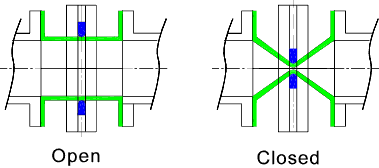
Pinch Valve
Check Valves
Check valves are automatic in operation and designed to prevent reversal of flow in fluid piping systems.
The valves are maintained open by the flow of fluid in the forward direction and are closed by back pressure of the fluid
or by the weight of the closing mechanism or by a spring force. Various designs are available
as listed below..
- Swing check
- Tilting disc
- Ball lift type
- Disc lift type
- Piston check
- Stop check
|
The range of check valve sizes range from 6mm to massive units of 3000mm dia and more.
The swing check variation is a low pressure drop unit based on a hinged disc. This type of valve
is suitable for low velocity applications with infrequent velocity reversals. The valve can be fitted
with external weights to allow faster closure to reduce water hammer or shock pressure on flow reversal. External systems can also
be included to force the valve closed in the event of a local fire...
The lift check valve and piston check variation are used for higher duty applications. The valve is forced
open by the fluid flowing up through the valve and is closed on fluid reversal by gravity, back pressure or by spring force.
The tilting disc variation on the swing check valve provides improve speed of operation and pressure performance and
is probably the most popular design of check valve used in the process industry..
|
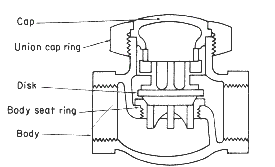
Lift Check Valve
|
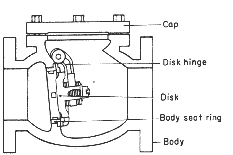
Swing Check Valve
|
|